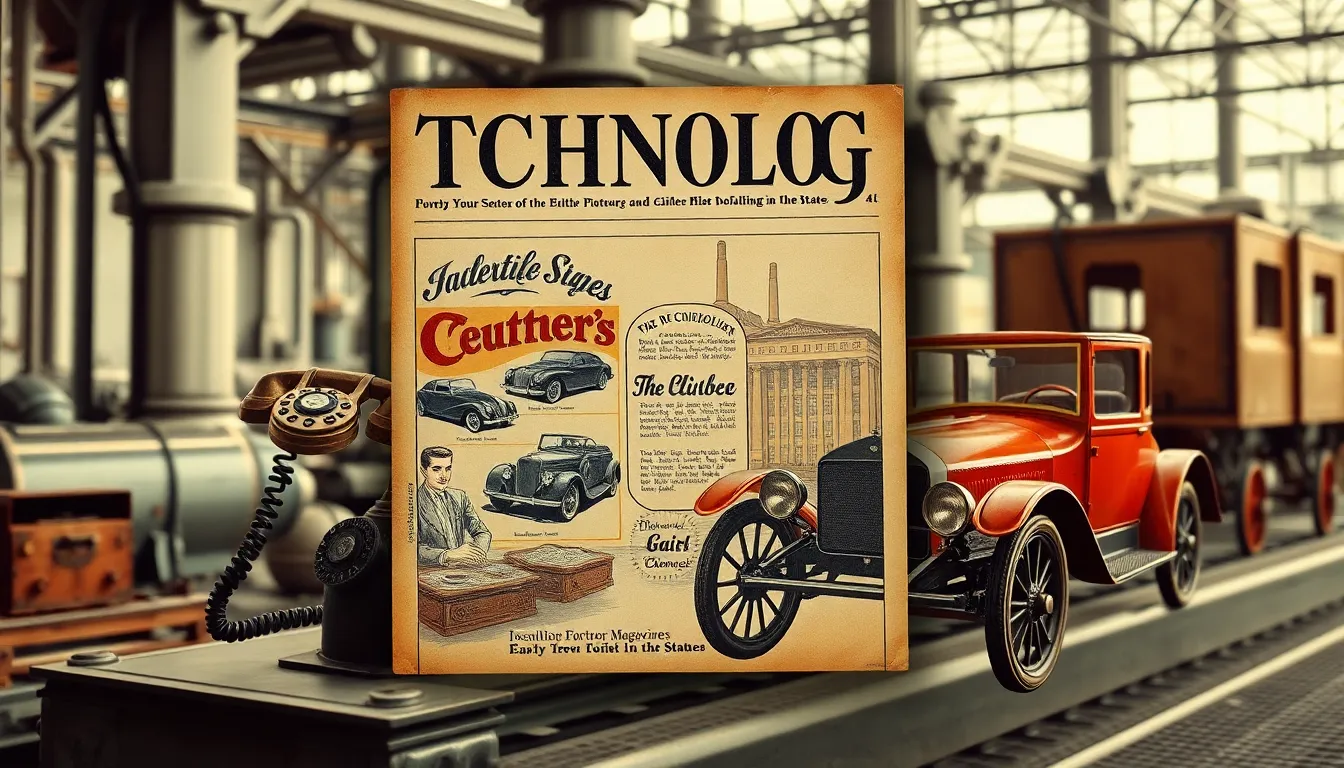From the days of bulky print editions to sleek digital formats, technology magazines have undergone a transformation that’s as fascinating as the gadgets they cover. Once the go-to source for tech enthusiasts, these publications now face the challenge of keeping up in a fast-paced digital landscape. But fear not—while the ink may be drying up, the innovation is just getting started.
Imagine flipping through glossy pages filled with the latest breakthroughs and nerdy insights, only to find it’s all available at the swipe of a finger. The evolution of technology magazines isn’t just about survival; it’s about thriving in a world where information travels faster than a Wi-Fi signal. Join the journey through time as we explore how these magazines have adapted, evolved, and sometimes hilariously stumbled their way into the hearts of readers everywhere.
Table of Contents
ToggleOverview Of Technology Magazines
Technology magazines play a crucial role in documenting advancements and trends within the tech industry. They serve as valuable sources of information, offering insights into new products, innovations, and best practices.
Importance Of Technology Magazines
Technology magazines foster informed discussions about the rapid evolution of technology. They deliver critical analyses, keeping readers updated on industry shifts. Subscribers gain access to expert opinions and in-depth reviews, essential for making informed decisions about tech purchases. Furthermore, these magazines often spotlight emerging technologies, guiding consumers through a maze of options. Readers also appreciate the balanced coverage of trends and ethical considerations in technology.
Key Players In The Market
Several notable publications dominate the technology magazine sector. Wired, recognized for its forward-thinking perspectives, explores the interplay of technology, culture, and politics. Popular Mechanics appeals with practical advice on technology-related projects and innovations. Technology Review, published by MIT, emphasizes scientific advancements and their implications for society. Additionally, TechCrunch focuses on startups, investments, and major technology news, catering to entrepreneurs and investors alike. Each of these magazines contributes uniquely to shaping the landscape of technology journalism.
Historical Evolution Of Technology Magazines

Technology magazines have undergone significant changes, transitioning from print to digital formats while facing ongoing challenges in the fast-paced digital landscape.
Early Beginnings
Early technology magazines emerged in the late 19th and early 20th centuries, focusing on innovations like the telephone and the automobile. Publications such as Popular Mechanics debuted in 1902, providing readers with practical insights into emerging technologies. They aimed to educate the public about new inventions and their applications. Another noteworthy title, Radio News, began in 1922, highlighting developments in the radio industry. These early magazines laid the groundwork for technology journalism, establishing a platform for discussion about advancements in engineering and manufacturing.
Major Milestones
The 1980s marked a pivotal moment for technology magazines with the rise of personal computing. Wired launched in 1993, revolutionizing the genre by blending technology with culture, art, and politics. This shift highlighted the growing importance of technology in everyday life. In the 2000s, online formats began reshaping content consumption, prompting magazines like TechCrunch to embrace the digital realm. Increased accessibility became apparent as readers shifted towards online platforms for news and reviews. The emergence of mobile devices further accelerated this transformation, with magazines adapting their content to fit smaller screens while maintaining relevance in a rapidly changing industry.
Impact Of Digital Transformation
Digital transformation significantly influenced technology magazines, driving dramatic changes in how they operate. This evolution emphasizes the importance of adapting to readers’ preferences and technological advancements.
Shift To Online Platforms
Magazines transitioned from print to online platforms, reaching broader audiences. Popular Mechanics and Wired recognized the need to engage readers digitally, launching websites and mobile applications. Readers appreciate instant access to content that aligns with their busy schedules. News cycles shortened, prompting tech publications to provide real-time updates. Adapting to online formats allowed magazines to grow their readership and enhance interactivity through comments and social media sharing.
Changes In Content Delivery
Content delivery evolved with a focus on multimedia elements. Videos, podcasts, and infographics enriched the reading experience, making it more engaging. TechCrunch led by offering timely news updates and expert opinions in diverse formats. Readers benefit from easy navigation and tailored content recommendations based on their interests. This shift encourages creativity in storytelling, enabling magazines to present complex topics in simpler, more digestible ways. Engaging formats contribute to increased user interaction, fostering a community around technology discussion.
Current Trends In Technology Magazines
Modern technology magazines emphasize specialization and relevance. Readers crave specific, expert insights into unique areas within technology. By focusing on niche topics, publications like Wired and TechCrunch attract audiences interested in fields like cybersecurity, artificial intelligence, or blockchain. This targeted approach allows magazines to build authority while catering to the diverse interests of tech enthusiasts.
Focus On Niche Topics
Niche topics gain traction as technology evolves rapidly. Publications increasingly explore subfields to deliver tailored content. Readers benefit from in-depth articles on specific themes, such as ethical hacking or emerging startups. Industry experts often contribute, enhancing credibility and fostering discussions. Tech magazines highlight these themes to engage specialized audiences, ensuring they remain competitive in a crowded market.
Integration Of Multimedia Content
Multimedia content elevates the reader experience in technology magazines. Integration of videos, podcasts, and infographics captures attention and conveys complex information effectively. Online platforms leverage these formats to provide richer storytelling and deeper insights. Readers enjoy interactive elements that enhance comprehension and engagement. Publications consistently incorporate multimedia to adapt to changing consumption habits, establishing a more dynamic connection with their audience.
Future Of Technology Magazines
Technology magazines are poised for significant changes as they adapt to evolving reader interests and technological advancements. Innovations in the publishing landscape create opportunities for these publications to reimagine their roles in the digital age.
Predictions And Expectations
Increased personalization stands as a key trend for technology magazines. Readers expect tailored content that aligns with their specific interests in technology. Emerging technologies such as artificial intelligence may enhance content creation and curation. More interactive formats, including augmented reality features, also attract readership by providing immersive experiences. Additionally, the integration of subscription models becomes more prevalent, offering exclusive content to dedicated audiences. As a result, magazines may establish deeper connections with readers, fostering loyalty and engagement.
Challenges Ahead
The growth of misinformation poses a significant challenge to technology magazines. Readers can easily encounter unreliable sources, making it crucial for established publications to maintain credibility. Swift changes in technology demand rapid content updates, requiring editors to strike a balance between thorough analysis and timely reporting. Audience expectations for diverse content increase competition among publications, compelling them to innovate continually. Furthermore, adapting to evolving monetization strategies presents financial hurdles. As digital advertising landscapes shift, magazines must explore alternative revenue streams while ensuring quality content remains a priority.
The journey of technology magazines showcases their resilience and adaptability in a fast-paced digital world. As they navigate challenges and embrace innovation, these publications continue to play a vital role in informing and engaging audiences. Their ability to blend traditional journalism with modern digital formats ensures that readers receive timely insights into the ever-evolving tech landscape.
Looking ahead, technology magazines will need to harness new tools and trends to stay relevant. By focusing on specialization and enhancing reader experiences through multimedia content, they can foster deeper connections with their audience. The future holds exciting possibilities for these publications as they strive to maintain credibility and relevance in an increasingly crowded market.





